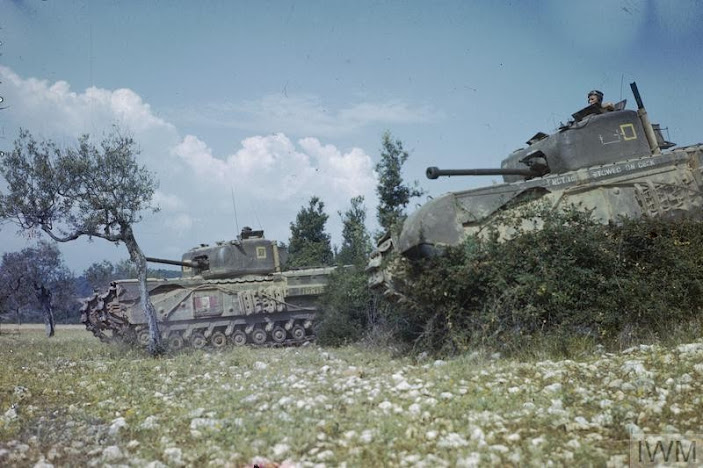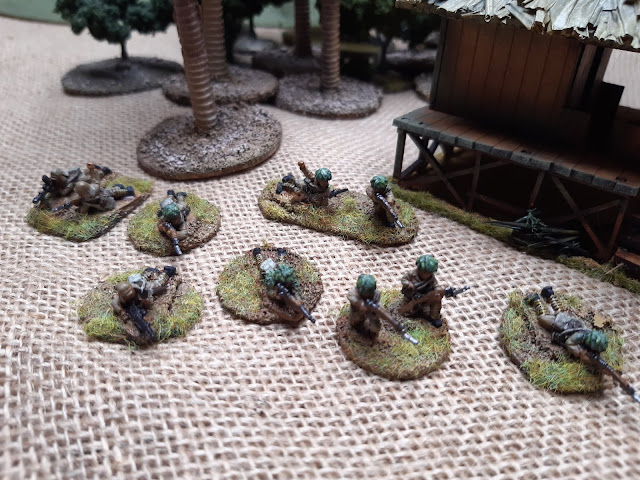Grenade launcher section is my first venture into the Far East.
Pennies a bit short in January but I wanted to get started so I purchased these from Early War Miniatures. A grenade launcher squad of three 50mm knee mortars and 5 riflemen in a mix of helmets and iconic field caps with an sword wielding officer ( a bit strange for a support company but Banzai! I suppose)
I might find a more appropriate officer wielding far more deadly binoculars later . I like them I here mixed things about EWM but I have had a lot of stuff mainly British tankers and liked them all. They painted up nicely. I also like the Type 97 mortars I will have a battery of 2 of these eventually. I really like the Type 92 "woodpecker" Nambu machine gun another support option for the platoon.

Next months pay check goes on the rest of the huge Japanese platoons.
I have just added the 1:72miniatures Payag Hut to my terrain collection with an eye to some Burmese adventures when the Battlegroup Pacific theatre book come out later this year. I am looking forward to matching the Imperial Japenese Infantry against my Indian infantry.
Lovely mdf jungle hut in mdf. I softened the edges a bit then added a jungle leaf roof.
I have added a 80mm mortar team to my IJA forces. This mortar battery has a forward observer to call in fire.
One slightly unusual features of Japanese infantry is the type 10 grenade launcher. These were often concentrated into a battery. This set are from EWM. I have always struggled to make good use of my British 2" mortars. I look forward to devising a tactic for my grenade launcher battery.
The type Type 92 HMG deployed next to the Payag hut.
Japanese infantry section from the excellent Japanese pacific Infantry from 1:72 miniature excellent range including the Type 99 LMG on the left.
More infantry in a mixture of helmets and caps
Two snipers one in helmet and one in cap take position in the treeline. I have more of these to put in "spider holes" 1:72 miniatures do some nice snipers up trees.
Advancing infantry in Sen-bou caps all from 1:72 miniatures
Pennies a bit short in January but I wanted to get started so I purchased these from Early War Miniatures. A grenade launcher squad of three 50mm knee mortars and 5 riflemen in a mix of helmets and iconic field caps with an sword wielding officer ( a bit strange for a support company but Banzai! I suppose)
I might find a more appropriate officer wielding far more deadly binoculars later . I like them I here mixed things about EWM but I have had a lot of stuff mainly British tankers and liked them all. They painted up nicely. I also like the Type 97 mortars I will have a battery of 2 of these eventually. I really like the Type 92 "woodpecker" Nambu machine gun another support option for the platoon.

Next months pay check goes on the rest of the huge Japanese platoons.
 |
| My new jungle hut finished with some Japanese Infantry for scale |
I have added a 80mm mortar team to my IJA forces. This mortar battery has a forward observer to call in fire.
 |
| 81mm type 97 mortar battery and forward observers from EWM and 1:72 miniatures |
One slightly unusual features of Japanese infantry is the type 10 grenade launcher. These were often concentrated into a battery. This set are from EWM. I have always struggled to make good use of my British 2" mortars. I look forward to devising a tactic for my grenade launcher battery.
The type Type 92 HMG deployed next to the Payag hut.
Japanese infantry section from the excellent Japanese pacific Infantry from 1:72 miniature excellent range including the Type 99 LMG on the left.
More infantry in a mixture of helmets and caps
Two snipers one in helmet and one in cap take position in the treeline. I have more of these to put in "spider holes" 1:72 miniatures do some nice snipers up trees.
Advancing infantry in Sen-bou caps all from 1:72 miniatures
















Comments
Post a Comment